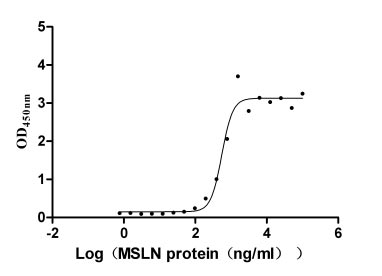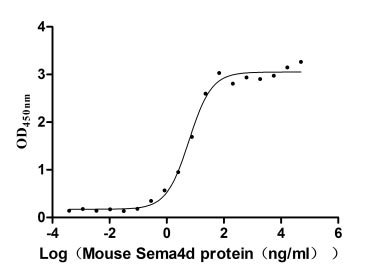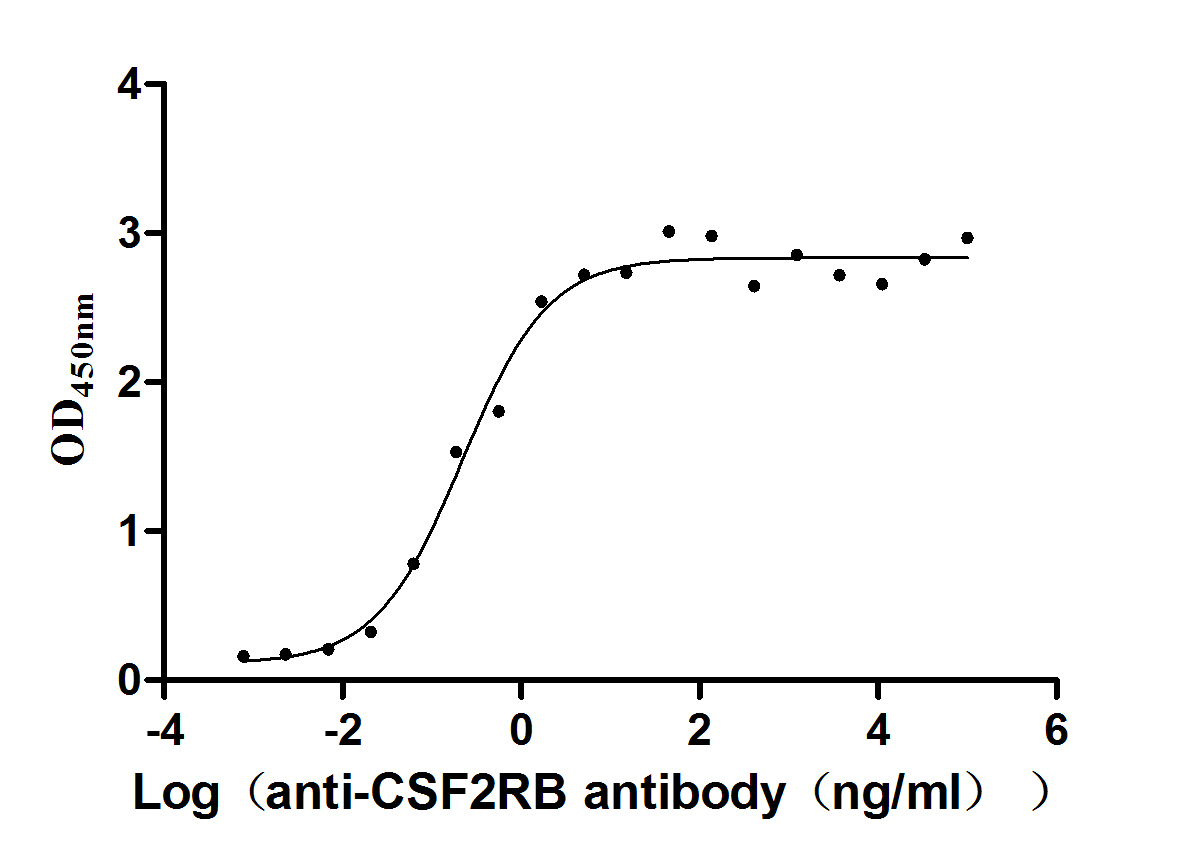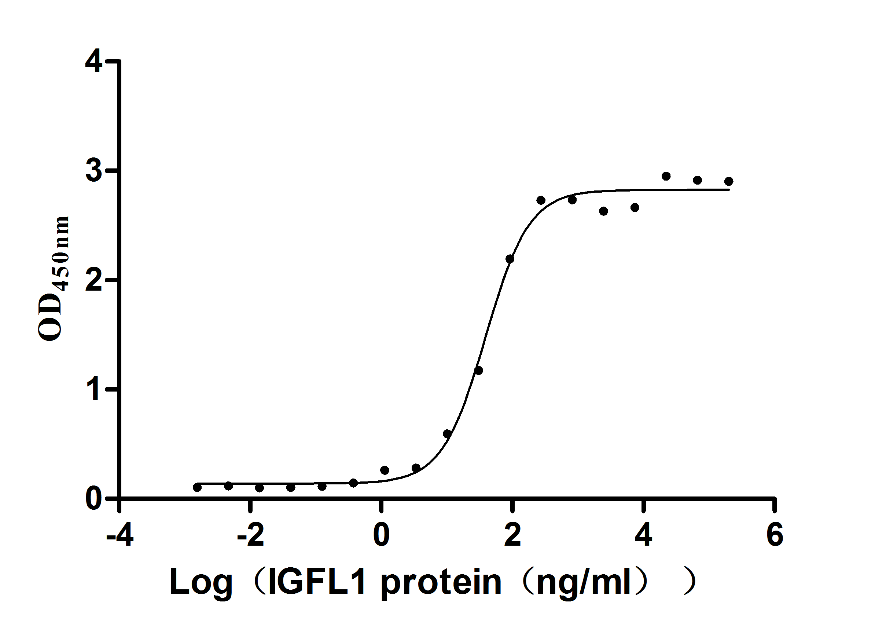Recombinant Rat Proteinase-activated receptor 2 (F2rl1)
-
货号:CSB-CF737213RA
-
规格:
-
来源:in vitro E.coli expression system
-
其他:
产品详情
-
基因名:
-
Uniprot No.:
-
别名:F2rl1; Par2; Proteinase-activated receptor 2; PAR-2; Coagulation factor II receptor-like 1; Thrombin receptor-like 1
-
种属:Rattus norvegicus (Rat)
-
蛋白长度:Full Length of Mature Protein
-
表达区域:37-397
-
氨基酸序列SLIGRLDTPPPITGKGAPVEPGFSVDEFSASVLTGKLTTVFLPVIYIIVFVIGLPSNGMA LWVFFFRTKKKHPAVIYMANLALADLLSVIWFPLKISYHLHGNDWTYGDALCKVLIGFFY GNMYCSILFMTCLSVQRYWVIVNPMGHSRKRANIAVGVSLAIWLLIFLVTIPLYVMRQTI YIPALNITTCHDVLPEEVLVGDMFSYFLSLAIGVFLFPALLTASAYVLMIKTLRSSAMDE HSEKKRRRAIRLIITVLSMYFICFAPSNVLLVVHYFLIKSQRQSHVYALYLVALCLSTLN SCIDPFVYYFVSKDFRDQARNALLCRSVRTVKRMQISLTSNKFSRKSSSYSSSSTSVKTS Y
Note: The complete sequence including tag sequence, target protein sequence and linker sequence could be provided upon request. -
蛋白标签:N-terminal 10xHis-tagged
-
产品提供形式:Liquid or Lyophilized powder
Note: We will preferentially ship the format that we have in stock, however, if you have any special requirement for the format, please remark your requirement when placing the order, we will prepare according to your demand. -
缓冲液:Lyophilized from Tris/PBS-based buffer, 6% Trehalose, pH 8.0
-
储存条件:Store at -20°C/-80°C upon receipt, aliquoting is necessary for mutiple use. Avoid repeated freeze-thaw cycles.
-
保质期:The shelf life is related to many factors, storage state, buffer ingredients, storage temperature and the stability of the protein itself.
Generally, the shelf life of liquid form is 6 months at -20°C/-80°C. The shelf life of lyophilized form is 12 months at -20°C/-80°C. -
货期:Basically, we can dispatch the products out in 1-3 working days after receiving your orders. Delivery time may differ from different purchasing way or location, please kindly consult your local distributors for specific delivery time.Note: All of our proteins are default shipped with normal blue ice packs, if you request to ship with dry ice, please communicate with us in advance and extra fees will be charged.
-
注意事项:Repeated freezing and thawing is not recommended. Store working aliquots at 4°C for up to one week.
-
Datasheet & COA:Please contact us to get it.
相关产品
靶点详情
-
功能:Receptor for trypsin and trypsin-like enzymes coupled to G proteins. Its function is mediated through the activation of several signaling pathways including phospholipase C (PLC), intracellular calcium, mitogen-activated protein kinase (MAPK), I-kappaB kinase/NF-kappaB and Rho. Can also be transactivated by cleaved F2R/PAR1. Involved in modulation of inflammatory responses and regulation of innate and adaptive immunity, and acts as a sensor for proteolytic enzymes generated during infection. Generally is promoting inflammation. Can signal synergistically with TLR4 and probably TLR2 in inflammatory responses and modulates Tlr3 signaling. Has a protective role in establishing the endothelial barrier; the activity involves coagulation factor X. Regulates endothelial cell barrier integrity during neutrophil extravasation, probably following proteolytic cleavage by PRTN3. Proposed to have a bronchoprotective role in airway epithelium, but also shown to compromise the airway epithelial barrier by interrupting E-cadherin adhesion. Involved in the regulation of vascular tone; activation results in hypotension presumably mediated by vasodilation. Associates with a subset of G proteins alpha subunits such as GNAQ, GNA11, GNA14, GNA12 and GNA13, but probably not with G(o) alpha, G(i) subunit alpha-1 and G(i) subunit alpha-2. Believed to be a class B receptor which internalizes as a complex with arrestin and traffic with it to endosomal vesicles, presumably as desensitized receptor, for extended periods of time. Mediates inhibition of TNF-alpha stimulated JNK phosphorylation via coupling to G GNAQ and GNA11; the function involves dissociation of RIPK1 and Tradd from TNFR1. Mediates phosphorylation of nuclear factor NF-kappa-B RELA subunit at 'Ser-536'; the function involves Ikbkb and is predominantly independent of G proteins. Involved in cellular migration. Involved in cytoskeletal rearrangement and chemotaxis through beta-arrestin-promoted scaffolds; the function is independent of GNAQ and GNA11 and involves promotion of cofilin dephosphorylation and actin filament severing. Induces redistribution of COPS5 from the plasma membrane to the cytosol and activation of the JNK cascade is mediated by Cops5. Involved in the recruitment of leukocytes to the sites of inflammation and is the major PAR receptor capable of modulating eosinophil function such as proinflammatory cytokine secretion, superoxide production and degranulation. During inflammation promotes dendritic cell maturation, trafficking to the lymph nodes and subsequent T-cell activation. Involved in antimicrobial response of innate immune cells; activation enhances phagocytosis of Gram-positive and killing of Gram-negative bacteria. Acts synergistically with interferon-gamma in enhancing antiviral responses.
-
基因功能参考文献:
- Our study findings demonstrated that PAR2-induced relaxations of aortas of aged spontaneously hypertensive rats was impaired, and this impaired aortic relaxation may be attributed to decreased NO bioavailability rather than altered NO sensitivity unrelated to the Akt activity.PAR2 activation is a potential therapeutic target to improve chronic hypertension-associated vasculopathies. PMID: 29709920
- The proteinase-activated receptor-2 signal in muscle sensory nerves contributes to the amplified exercise pressor reflex via TRPA1 mechanisms in rats with femoral artery ligation. PMID: 29131007
- The results of this study suggest that PAR2 plays an important role in mediating renal injury induced by glomerulosclerosis. PMID: 28245472
- PAR2 stimulation of NO production via an additional pathway that targets phosphorylation of Ser1177-eNOS suggests a regulatory mechanism for sustaining agonist-mediated vasodilation in metabolic syndrome. PMID: 26760532
- XZP significantly alleviates breast cancer-induced bone pain by inhibiting the PAR2 signaling pathway. PMID: 26133236
- The PAR-2 carboxyl tail was found to control the receptor localization, internalization, intracellular Ca(2+) responses and signaling to ERK and AKT. PMID: 25519044
- Results provide evidence for a direct relationship between PAR-2 activation and peripheral sympathetic activity via the N-type Ca2+ channels. PMID: 25410909
- PAR2-mediated relaxation is preserved in the small mesenteric arteries of rats with metabolic syndrome PMID: 25109437
- Data suggest that the trypsin (TRP) generated during acute pancreatitis could be involved in the progression of lung injury through the activation of protease-activated receptor-2 (PAR-2) in alveolar macrophages. PMID: 24897276
- These results suggest that the increased expression of PAR2 in the dorsal root ganglia may contribute to the development of mechanical allodynia and thermal hyperalgesia associated with bone cancer rats. PMID: 24057889
- The PAR2 may function as a key receptor in calcium-related cell homeostasis under pathophysiological conditions such as tissue injury or inflammation. PMID: 23463389
- The present study demonstrated that activation of PAR2 triggered NF-kappaB signaling and significantly upregulated the BDNF function. PMID: 24886294
- Blockade of Par2 activation results in a decrease of endothelin-1 levels in kidney in an endotoxemic model. PMID: 24641950
- The systolic blood pressure of unrestrained mice can be lowered by chronic in-vivo activation of PAR2. PMID: 23627841
- Cromolyn sodium may reduce intestinal ischemia-reperfusion injury by stabilizing mast cell membrane and inhibiting the expressions of tryptase and PAR-2. PMID: 23290058
- Cross-talk between PAR2 and TLR4 contributes to vascular homeostasis PMID: 22957757
- Renal proteinase-activated receptor 2 has a role in the control of blood pressure and plasma potassium level PMID: 23430254
- in the rat model of Trichinella spiralis infection, alterations of intestinal PAR-2 function and expression depend on the inflammatory phase considered. PMID: 23238933
- PAR2 activation is critical to induction of nerve injury-induced neuronal hyperexcitability and cAMP-PKA activation. PMID: 22541444
- Tryptase released from mast cells mediates acute lung injury induced by intestinal ischemia-reperfusion by activating PAR-2 to produce IL-8. PMID: 22200983
- KLK8 and KLK14 can signal differentially via the PARs to affect tissue function PMID: 22505524
- PAR2 receptor activation enhances pain response, potentially via inhibition of dorsal horn GABAergic neurotransmission. PMID: 22018669
- found that up-regulation of PAR-2 is dependent on PKC activity, mostly via its Ca(2)-sensitive isoforms PMID: 22227167
- Study identifies a novel role of PAR-2 in vascular remodeling in the lung and suggests PAR-2 inhibition reverses experimental pulmonary hypertension. PMID: 22461388
- Both PAR-2 and mast cells are involved in the pathogenesis of small intestinal mucosa injury induced by diclofenac. PMID: 21914290
- These results suggest a cellular mechanism for the pathophysiological effects of PAR-2 activation on myometrial contractility during pregnancy. PMID: 22244874
- The disease-modifying properties of a PAR2 antagonist in both acute and chronic experimental colitis strongly support a pathogenic role for PAR2 and PAR2-activating proteases. PMID: 22028393
- ISP1 might signal to cells by cleaving and activating proteinase-activated receptors (PARs) and therefore assessed PARs 1, 2 and 4 as potential ISP1 targets. PMID: 22132161
- a new mode of PAR regulation that involves biased PAR(2) signaling by neutrophil elastase and a disarming/silencing effect of cathepsin-G and proteinase-3. PMID: 21576245
- Thermal hyperalgesia in chronic pancreatitis is associated with an up-regulation of the PAR2 in dorsal root ganglia. PMID: 21311307
- Expression of Par-2 mRNA and protein in the intestinal mucosa was increased after reperfusion following ischemia. PMID: 21461568
- The data indicated that bacillary dysentery exerted a long-term downregulation on the expression of PAR-2 in distal colon. PMID: 20347884
- Oxidative stress upregulates PAR-2 in endothelial cells, thereby enhancing the endothelium-dependent relaxant response to PAR-2 agonists in rat aortas. PMID: 20431298
- PAR-2 activation leads to vasodilation of dural arteries and these responses are partially mediated by nitric oxide. PMID: 20487037
- PAR-2 mRNA and protein expression were consistent with the increase of the mast cells in experimental rat liver fibrosis. PMID: 17064469
- PAR-2 agonist SLIGRL-NH2 could reduce myocardial apoptosis by upregulating the Bcl-2 and PAR-2 mRNA level and downregulating Bax expression in a dose-dependent manner. PMID: 20128384
- PAR2 expression nor vasodilator function, was altered in the middle cerebral arteries of spontaneously hypertensive rats after hypertensive encephalopathy or cerebral hemorrhage. PMID: 19954757
- Activation of PAR(2) modulates the acid signaling in pulmonary sensory neurons. PMID: 20044436
- PAR-2 plays a key role in the inflammatory and coagulation process of LPS-induced renal failure PMID: 19333145
- These results suggest that suppression of PAR-2 expression under inflammatory conditions is at least partially induced by nitric oxide produced in the colonic muscularis externa by proinflammatory cytokines. PMID: 20046028
- Inflammation causes an up-regulation of the NMDA receptor and the activation of the PAR2 receptor expressed on colospinal afferent neurons. PMID: 19772634
- Rat stellate cells activated by culture on plastic showed a progressive increase in expression of proteinase-activated receptor-1 and -2 mRNA and proteinase-activated receptor-2 protein as they transformed to a myofibroblastic phenotype PMID: 11867180
- a possible role to promote visceral hyperalgesia in rats. PMID: 11910355
- findings indicate that PAR-2 is expressed in the afferent arteriole and that its activation elicits afferent arteriolar vasodilation PMID: 11934700
- enhanced PAR-2 activation improves efficiency of ischemic preconditioning and reduces cardiac inflammation in the rat heart PMID: 12003804
- Expression of protease-activated receptor 2 does not change significantly in the hippocampus following severe ischemic insult. PMID: 12165407
- Role of N-methyl-D-aspartate receptors and the nitric oxide pathway in nociception/hyperalgesia elicited by protease-activated receptor-2 activation PMID: 12183046
- examined the distribution of PAR-2 in the pancreas and parotid gland, and characterized the PAR-2-mediated secretion of amylase by these tissues in vivo PMID: 12231404
- Par-2 mRNA is upregulated in the developing rat eye and adult retina as early as 6 hr after optic nerve crush. PMID: 12836167
- protease-activated receptor 2 may have a dual role in acute pancreatitis: protecting acinar and duct cells against pancreatitis-induced cell damage while mediating or aggravating the systemic complications of acute pancreatitis PMID: 15188179
显示更多
收起更多
-
亚细胞定位:Cell membrane; Multi-pass membrane protein.
-
蛋白家族:G-protein coupled receptor 1 family
-
数据库链接:
KEGG: rno:116677
STRING: 10116.ENSRNOP00000058298
UniGene: Rn.10543
Most popular with customers
-
Recombinant Human Mucin-16 (MUC16), partial (Active)
Express system: Mammalian cell
Species: Homo sapiens (Human)
-
Recombinant Human Pro-neuregulin-1, membrane-bound isoform (NRG1), partial (Active)
Express system: Mammalian cell
Species: Homo sapiens (Human)
-
Recombinant Mouse Semaphorin-4D (Sema4d), partial (Active)
Express system: Mammalian cell
Species: Mus musculus (Mouse)
-
Recombinant Human Cytokine receptor common subunit beta (CSF2RB), partial (Active)
Express system: Mammalian cell
Species: Homo sapiens (Human)
-
Recombinant Human IGF-like family receptor 1 (IGFLR1), partial (Active)
Express system: Mammalian cell
Species: Homo sapiens (Human)
-
Recombinant Human Oncostatin-M (OSM), partial (Active)
Express system: Mammalian cell
Species: Homo sapiens (Human)
-
Recombinant Human Transmembrane 4 L6 family member 1(TM4SF1)-VLPs (Active)
Express system: Mammalian cell
Species: Homo sapiens (Human)
-
Recombinant Human C-C chemokine receptor type 9 (CCR9)-VLPs (Active)
Express system: Mammalian cell
Species: Homo sapiens (Human)



-AC1.jpg)
















